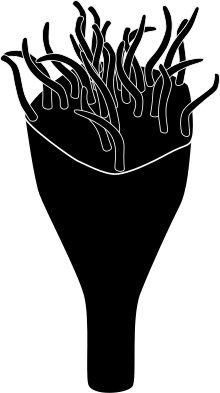| Revision as of 02:44, 24 June 2023 editPlantdrew (talk | contribs)Autopatrolled, Extended confirmed users, New page reviewers645,951 edits added Category:Blastozoa using HotCat← Previous edit | Latest revision as of 15:56, 23 January 2024 edit undoEntranced98 (talk | contribs)Extended confirmed users, Pending changes reviewers, Rollbackers174,265 edits Adding short description: "Extinct genus of echinoderms"Tag: Shortdesc helper | ||
| (6 intermediate revisions by 5 users not shown) | |||
| Line 1: | Line 1: | ||
| {{Short description|Extinct genus of echinoderms}} | |||
| {{ |
{{Automatic taxobox | ||
| | image = Kinzercystis_durhami.svg | |||
| | image_caption = The lepidocystid ''Kinzercystis'' closely resembles ''Lepidocystis''. | |||
| | fossil_range = Cambrian Series 2 | | fossil_range = Cambrian Series 2 | ||
| | taxon = Lepidocystis | | taxon = Lepidocystis | ||
| }} | }} | ||
| '''''Lepidocystis''''' is a Palaeozoic genus of imbricate lepidocystoid eocrinoid, closely related to '']'',<ref>{{Cite journal | doi = 10.1111/j.1469-185x.1984.tb00411.x}}</ref><ref>{{Cite journal | doi=10.1098/rspb.2013.1197 | title=Cambrian spiral-plated echinoderms from Gondwana reveal the earliest pentaradial body plan | year=2013 | last1=Smith | first1=Andrew B. | last2=Zamora | first2=Samuel | journal=Proceedings of the Royal Society B: Biological Sciences | volume=280 | issue=1765 | pmid=23804624 | pmc=3712455 }}</ref>, with which it attached to firm substrates |
'''''Lepidocystis''''' is a Palaeozoic genus of imbricate lepidocystoid eocrinoid, closely related to '']'',<ref>{{Cite journal | doi = 10.1111/j.1469-185x.1984.tb00411.x| title = The Early Radiation and Phylogeny of Echinoderms| year = 1984| last1 = Paul| first1 = C. R. C.| last2 = Smith| first2 = A. B.| journal = Biological Reviews| volume = 59| issue = 4| pages = 443–481| s2cid = 86572427}}</ref><ref>{{Cite journal | doi=10.1098/rspb.2013.1197 | title=Cambrian spiral-plated echinoderms from Gondwana reveal the earliest pentaradial body plan | year=2013 | last1=Smith | first1=Andrew B. | last2=Zamora | first2=Samuel | journal=Proceedings of the Royal Society B: Biological Sciences | volume=280 | issue=1765 | pmid=23804624 | pmc=3712455 }}</ref> It bore a stalk, with which it attached to firm substrates;<ref>{{Cite journal | url =https://doi.org/10.1016/j.earscirev.2017.06.018 | ||
| | doi =10.1016/j.earscirev.2017.06.018 | | doi =10.1016/j.earscirev.2017.06.018 | ||
| | title =The Cambrian Substrate Revolution and the early evolution of attachment in suspension-feeding echinoderms | | title =The Cambrian Substrate Revolution and the early evolution of attachment in suspension-feeding echinoderms | ||
| Line 21: | Line 24: | ||
| | bibcode =2017ESRv..171..478Z | | bibcode =2017ESRv..171..478Z | ||
| | s2cid =134049725 | | s2cid =134049725 | ||
| }}</ref> and brachioles arising as lateral branches from its arms.<ref>{{cite journal | doi = 10.1111/j.1469-185X.1984.tb00411.x| title = The Early Radiation and Phylogeny of Echinoderms| year = 1984| last1 = Paul| first1 = C. R. C.| last2 = Smith| first2 = A. B.| journal = Biological Reviews| volume = 59| issue = 4| pages = 443–481| s2cid = 86572427}}</ref> | |||
| }}</ref> | |||
| It is only known from the late Botomian = ] Kinzers Formation.<ref>{{Cite journal | doi = 10.1080/14772019.2018.1541485}}</ref> | It is only known from the late Botomian = ] Kinzers Formation.<ref>{{Cite journal | doi = 10.1080/14772019.2018.1541485| title = Morphology, palaeoecology and phylogenetic interpretation of the Cambrian echinoderm ''Vyscystis'' (Barrandian area, Czech Republic)| year = 2019| last1 = Nohejlová| first1 = Martina| last2 = Nardin| first2 = Elise| last3 = Fatka| first3 = Oldřich| last4 = Kašička| first4 = Libor| last5 = Szabad| first5 = Michal| journal = Journal of Systematic Palaeontology| volume = 17| issue = 19| pages = 1619–1634| s2cid = 92231073}}</ref> | ||
| ==References== | ==References== | ||
| {{Reflist}} | {{Reflist}} | ||
| {{Taxonbar|from=Q120395525}} | |||
| ] | ] | ||
| ] | ] | ||
| ] | |||
| {{Cambrian-animal-stub}} | {{Cambrian-animal-stub}} | ||
Latest revision as of 15:56, 23 January 2024
Extinct genus of echinoderms
| Lepidocystis Temporal range: Cambrian Series 2 PreꞒ Ꞓ O S D C P T J K Pg N | |
|---|---|

| |
| The lepidocystid Kinzercystis closely resembles Lepidocystis. | |
| Scientific classification | |
| Domain: | Eukaryota |
| Kingdom: | Animalia |
| Phylum: | Echinodermata |
| Class: | †Eocrinoidea |
| Grade: | †Lepidocystoids |
| Genus: | †Lepidocystis |
Lepidocystis is a Palaeozoic genus of imbricate lepidocystoid eocrinoid, closely related to Kinzercystis, It bore a stalk, with which it attached to firm substrates; and brachioles arising as lateral branches from its arms.
It is only known from the late Botomian = Cambrian Series 2 Kinzers Formation.
References
- Paul, C. R. C.; Smith, A. B. (1984). "The Early Radiation and Phylogeny of Echinoderms". Biological Reviews. 59 (4): 443–481. doi:10.1111/j.1469-185x.1984.tb00411.x. S2CID 86572427.
- Smith, Andrew B.; Zamora, Samuel (2013). "Cambrian spiral-plated echinoderms from Gondwana reveal the earliest pentaradial body plan". Proceedings of the Royal Society B: Biological Sciences. 280 (1765). doi:10.1098/rspb.2013.1197. PMC 3712455. PMID 23804624.
- Zamora, Samuel; Deline, Bradley; Javier Álvaro, J.; Rahman, Imran A. (2017). "The Cambrian Substrate Revolution and the early evolution of attachment in suspension-feeding echinoderms". Earth-Science Reviews. 171: 478–491. Bibcode:2017ESRv..171..478Z. doi:10.1016/j.earscirev.2017.06.018. S2CID 134049725.
- Paul, C. R. C.; Smith, A. B. (1984). "The Early Radiation and Phylogeny of Echinoderms". Biological Reviews. 59 (4): 443–481. doi:10.1111/j.1469-185X.1984.tb00411.x. S2CID 86572427.
- Nohejlová, Martina; Nardin, Elise; Fatka, Oldřich; Kašička, Libor; Szabad, Michal (2019). "Morphology, palaeoecology and phylogenetic interpretation of the Cambrian echinoderm Vyscystis (Barrandian area, Czech Republic)". Journal of Systematic Palaeontology. 17 (19): 1619–1634. doi:10.1080/14772019.2018.1541485. S2CID 92231073.
This article related to a Cambrian animal is a stub. You can help Misplaced Pages by expanding it. |